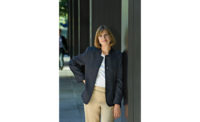Take It from the Top
Mayor Rahm Emanuel reinforces a legacy for the built environment.

Photo © Walter Mitchell/City of Chicago
Though Emanuel is no shrinking violet—he’s famous for dropping f-bombs and once mailed a dead fish to a pollster who ticked him off—the mayor at first neither wowed nor wooed the city’s architects. He kicked two of them—even the venerable Ben Weese—off the city’s landmarks commission and installed a celebrity chef and the obstetrician who delivered Barack Obama’s daughters. Huh? While there were some early good moves, such as installing protected bike lanes, architecture and urban design didn’t seem to be high on Emanuel’s agenda.
They are now. The mayor isn’t just presiding over the inaugural Chicago Architectural Biennial, which runs from October 3 to January 3 and is billed as North America’s largest survey of contemporary architecture. He is backing the exhibition enthusiastically. If nothing else, it offers relief from a drumbeat of bad news, from rising homicides to underfunded pensions. The biennial, he told me in a recent interview, aims to brand Chicago as “the place, as it always has been, of modern architecture.” With people around the world flocking to cities, he explained, there’s fresh urgency to making them livable and sustainable: “I think the conference is going to be an important part of that conversation, and I want Chicago dead center in the middle of it.”
The biennial’s leaders insist Emanuel’s passion for the event is genuine, not simply born of a boosterish desire to lure tourist dollars. According to biennial vice chair Jack Guthman, a Chicago zoning lawyer, the mayor’s involvement stems from Emanuel’s desire “to have Chicago again on the international stage, not just as a center where great buildings are built but also as a place where architectural ideas are being considered.”
Whatever the biennial’s outcome, the fiercely competitive, frequently wisecracking Emanuel is relishing not just new architecture but a wave of well-received public spaces, from the 606, a recently opened 2.7-mile trail and park system that is Chicago’s neighborhood-centric answer to New York’s tourist-mobbed High Line, to the extended downtown Riverwalk, where he drops by every so often for lunch. Because Emanuel grew up in the Chicago area—he and brothers Ezekiel, an esteemed bioethicist, and Ari, a powerhouse Hollywood agent, were raised in an affluent suburb—the river’s improbable transformation from toxic industrial waterway to postindustrial (albeit still-polluted) recreational amenity is particularly gratifying. When he was growing up, he said, no one would have believed that, one day, people would be going out to the river and “enjoying nature, eating lunch, having a drink, [and] listening to music.”
Asked if he’s relieved to be free from Washington’s political gridlock, the former Congressman and chief of staff in the Obama White House channels Edvard Munch’s Expressionist painting The Scream, clamping his hands on the sides of his head and shaping his lips to form an O. (When I compliment him on using an artistic allusion, Emanuel replies, “My parents paid for Sarah Lawrence. I’ve got to use that liberal-arts degree.”) To him, Washington is the land of political posturing, removed from gritty, everyday reality. “D.C. is Disneyland on the Potomac,” he said. “Here, you make a decision . . . see it through, and have an impact on the quality of life and the way you live your life.”
Yet building new public works is proving far easier for the mayor than solving Chicago’s most pressing problems, among them a credit rating reduced to junk status and shootings that continue to roil impoverished African-American neighborhoods. But Emanuel considers public works to be an important way to address Chicago’s fiscal woes, not a bread-and-circuses distraction from them. Since his 2011 pledge to turn the Chicago River into a “second waterfront,” on a par with Chicago’s celebrated lakefront, he claims that developers have committed to invest $8 billion in new riverfront buildings. To be sure, some of the projects would have happened anyway. Yet the forest of construction cranes along the river—symbols of both prosperity and Chicago’s capacity to reinvent itself—is nonetheless impressive.
Now in the fifth year of his mayoralty, Emanuel has emerged as both a “pick-up-the-baton” figure who has found ways to realize Daley-initiated projects like the 606, and one who is intent upon charting his own course. New riverfront boathouses, the Divvy bike-sharing network, and some 100 miles of new bike lanes are his initiatives, and he’s already built more of the downtown Riverwalk than Daley, with another extension still to come. As head of the city’s Public Building Commission, which erects libraries and other public buildings, Emanuel is forging alternatives to the cookie-cutter “prototypes” Daley backed on grounds of efficiency. “Public buildings don’t have to be just brick and mortar,” he said as his intense brown eyes took in the light-filled interior of the Chicago Public Library’s new Chinatown branch, an elegantly transparent rounded triangle by Brian Lee of the Chicago office of Skidmore, Owings & Merrill. “They can be real, great artworks.”
The library reveals another difference from Daley: Emanuel’s openness to modern architecture, a taste it took his predecessor years to cultivate. Asked to name his favorite Chicago architecture, the mayor lists Kohn Pedersen Fox’s 333 West Wacker, the exquisite contextual skyscraper that marks a bend in the Chicago River, and Frank Gehry’s Pritzker Pavilion in Millennium Park. “One of the things I constantly hear [from visitors],” Emanuel said, “is this: ‘What an incredibly beautiful city’ . . . And when they say it’s really beautiful, there’s two things they put side by side: one, they’re in awe of the size, scope, and scale of nature on [Lake Michigan]; and then, this incredibly human space, our architecture, and the way the city just looks and feels. The beauty of our architecture is one of a kind.”



